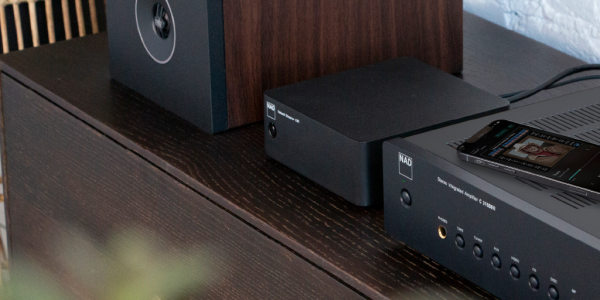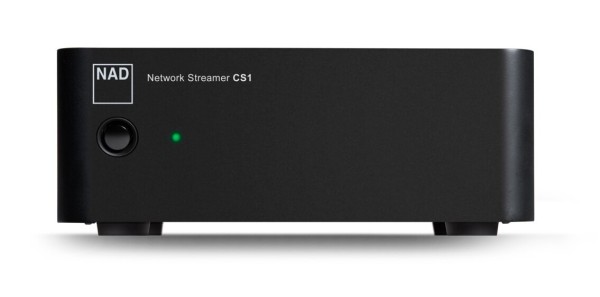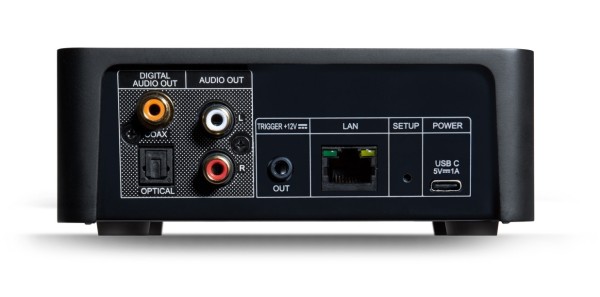

 NAD CS1 adds network streaming to any music system
Pickering, Ontario, Canada - January 24, 2023 - NAD Electronics, the highly regarded manufacturer of high-performance audio-video components, today announced the NAD CS1 Endpoint Network Streamer, a compact, minimalist design that makes it easy to add streaming capability to any music system. The CS1 will be available in retail shops and NADElectronics.com with a retail target price of US$349 / £299 / €399 / CDN$499 in March 2023.
Employing audiophile-grade components, the NAD CS1 can play high-resolution audio up to 24-bit/192kHz. It features Bluetooth, Ethernet, dual-band Wi-Fi and supports the most popular streaming and casting protocols, including Apple AirPlay 2, GoogleCast, Spotify Connect, Tidal Connect and Roon. Certification for network sharing via DNLA/UPnP protocols expected to be complete with retail available of CS1 in March 2023. That means listeners don’t have to install a dedicated app to use the CS1; they can control playback with the music apps they use every day.
OPTIONS UPON OPTIONS
There are many ways to play music through the NAD CS1 Endpoint Network Streamer. Listeners can use Bluetooth to pair the CS1 with a smartphone, tablet, or computer.
The CS1 offers many options for playing music over a home network. Listeners can use AirPlay 2 to stream CD-resolution audio from any app on an iPhone, iPad, or Mac, or from an iTunes library on a Windows PC. With GoogleCast, users can cue up music in any Cast-enabled app on a mobile device or personal computer, then transfer playback to the CS1.
NAD CS1 adds network streaming to any music system
Pickering, Ontario, Canada - January 24, 2023 - NAD Electronics, the highly regarded manufacturer of high-performance audio-video components, today announced the NAD CS1 Endpoint Network Streamer, a compact, minimalist design that makes it easy to add streaming capability to any music system. The CS1 will be available in retail shops and NADElectronics.com with a retail target price of US$349 / £299 / €399 / CDN$499 in March 2023.
Employing audiophile-grade components, the NAD CS1 can play high-resolution audio up to 24-bit/192kHz. It features Bluetooth, Ethernet, dual-band Wi-Fi and supports the most popular streaming and casting protocols, including Apple AirPlay 2, GoogleCast, Spotify Connect, Tidal Connect and Roon. Certification for network sharing via DNLA/UPnP protocols expected to be complete with retail available of CS1 in March 2023. That means listeners don’t have to install a dedicated app to use the CS1; they can control playback with the music apps they use every day.
OPTIONS UPON OPTIONS
There are many ways to play music through the NAD CS1 Endpoint Network Streamer. Listeners can use Bluetooth to pair the CS1 with a smartphone, tablet, or computer.
The CS1 offers many options for playing music over a home network. Listeners can use AirPlay 2 to stream CD-resolution audio from any app on an iPhone, iPad, or Mac, or from an iTunes library on a Windows PC. With GoogleCast, users can cue up music in any Cast-enabled app on a mobile device or personal computer, then transfer playback to the CS1.

 NAD CS1 front
Spotify Connect and Tidal Connect users can cue up music in the apps for those services, then easily transfer playback to the CS1. Roon subscribers can play music from their digital libraries and from streaming services with resolutions up to 24-bit/192kHz.
AUDIOPHILE-GRADE SOUND
The NAD CS1 Endpoint Network Streamer delivers the audio performance for which NAD is renowned. It features an advanced differential digital section based on Texas Instruments’ PCM5141 DAC, a design known for its extremely low noise, excellent dynamic performance, and immunity to clock jitter. It also has full MQA rendering and decoding capability for playing master quality music from Tidal.
FLEXIBLE CONNECTIVITY
Users can connect the CS1 to their home network via Wi-Fi or hardwire its LAN Ethernet port to their network router. The CS1 has a pair of RCA analogue outputs for connection to a stereo receiver, integrated amp, preamplifier, or a pair of powered speakers. The CS1 also has optical and coaxial outputs for sending digital audio at up to 24-bit/192kHz resolution to powered loudspeakers with digital inputs, or to a home theatre receiver or external DAC.
“Streaming has profoundly altered the way people discover and experience music,” said Cas Oostvogel, Product Manager of NAD Electronics. “The CS1 makes it easy to add streaming to a legacy stereo or home-theatre setup. Or someone could configure a low-footprint system for a den or home office by combining the CS1 with a pair of powered speakers. Streaming doesn’t get simpler than this.”
NAD CS1 front
Spotify Connect and Tidal Connect users can cue up music in the apps for those services, then easily transfer playback to the CS1. Roon subscribers can play music from their digital libraries and from streaming services with resolutions up to 24-bit/192kHz.
AUDIOPHILE-GRADE SOUND
The NAD CS1 Endpoint Network Streamer delivers the audio performance for which NAD is renowned. It features an advanced differential digital section based on Texas Instruments’ PCM5141 DAC, a design known for its extremely low noise, excellent dynamic performance, and immunity to clock jitter. It also has full MQA rendering and decoding capability for playing master quality music from Tidal.
FLEXIBLE CONNECTIVITY
Users can connect the CS1 to their home network via Wi-Fi or hardwire its LAN Ethernet port to their network router. The CS1 has a pair of RCA analogue outputs for connection to a stereo receiver, integrated amp, preamplifier, or a pair of powered speakers. The CS1 also has optical and coaxial outputs for sending digital audio at up to 24-bit/192kHz resolution to powered loudspeakers with digital inputs, or to a home theatre receiver or external DAC.
“Streaming has profoundly altered the way people discover and experience music,” said Cas Oostvogel, Product Manager of NAD Electronics. “The CS1 makes it easy to add streaming to a legacy stereo or home-theatre setup. Or someone could configure a low-footprint system for a den or home office by combining the CS1 with a pair of powered speakers. Streaming doesn’t get simpler than this.”

 NAD CS1 from rear
Key Features of the NAD CS1 Endpoint Network Streamer:
• Compact, minimalist design
NAD CS1 from rear
Key Features of the NAD CS1 Endpoint Network Streamer:
• Compact, minimalist design• Built-in Bluetooth 5.0
• Dual-band Wi-Fi plus LAN Ethernet port
• Support for network sharing via DLNA/UPnp* protocols
• Stereo analogue, optical digital, and coaxial digital outputs
• Premium differential DAC design based on Texas Instruments PCM5141 DAC, with support for 24-bit/192kHz high-resolution audio and MQA decoding
• Apple AirPlay 2 support allows CD-resolution streaming from any audio app on an iPhone, iPad, or Mac
• GoogleCast support allows playback at up to 24-bit/96kHz resolution from any Cast-enabled app on a smartphone, tablet, or personal computer
• Spotify Connect and Tidal Connect support lets users cue up music on a smart device, then transfer playback to the CS1
• Roon subscribers can stream audio to the CS1 from their personal libraries and online services supported by Roon in hi-res * Certification in process as of publishing date About NAD Electronics Founded in 1972 and now sold in over 80 countries, NAD Electronics is renowned for its award-winning line of high-quality components for audio, home theatre and custom installation applications. Since the beginning, NAD’s commitment to four core values – innovation, simplicity, performance, and value – have earned it a cult-like following that catapulted it to becoming a household name amongst audiophiles and music lovers alike. To this day, the brand continues to design and manufacture some of the most acclaimed and affordable hi-fi components that include modern features and technologies meant to appeal to a new generation of audiophiles. Media Contact
Company Name: NAD Electronics
Contact Person: June Ip
Email: Send Email
City: Pickering
State: ON
Country: Canada
Website: www.nadelectronics.com



 Front page layout
Site theme
Front page layout
Site theme